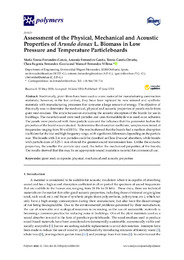Por favor, use este identificador para citar o enlazar este ítem:
https://hdl.handle.net/11000/34587Registro completo de metadatos
| Campo DC | Valor | Lengua/Idioma |
|---|---|---|
| dc.contributor.author | Ferrández-Villena, Manuel | - |
| dc.contributor.author | Garcia-Ortuño, Teresa | - |
| dc.contributor.author | FERRÁNDEZ, MARÍA TERESA | - |
| dc.contributor.author | Ferrández García, Antonio | - |
| dc.contributor.author | Ferrández García, Clara Eugenia | - |
| dc.contributor.other | Departamentos de la UMH::Ingeniería | es_ES |
| dc.date.accessioned | 2025-01-16T17:36:15Z | - |
| dc.date.available | 2025-01-16T17:36:15Z | - |
| dc.date.created | 2020 | - |
| dc.identifier.citation | Polymers | es_ES |
| dc.identifier.issn | 2073-4360 | - |
| dc.identifier.uri | https://hdl.handle.net/11000/34587 | - |
| dc.description.abstract | Traditionally, plant fibres have been used as a raw material for manufacturing construction materials; however, in the last century, they have been replaced by new mineral and synthetic materials with manufacturing processes that consume a large amount of energy. The objective of this study was to determine the mechanical, physical and acoustic properties of panels made from giant reed residues. The article focuses on evaluating the acoustic absorption of the boards for use in buildings. The materials used were reed particles and urea–formaldehyde was used as an adhesive. The panels were produced with three particle sizes and the influence that this parameter had on the properties of the board was evaluated. To determine the absorption coe cient, samples were tested at frequencies ranging from 50 to 6300 Hz. The results showed that the boards had a medium absorption coe cient for the low and high frequency range, with significant di erences depending on the particle size. The boards with 2–4 mm particles could be classified as Class D sound absorbers, while boards with particle sizes of 0.25–1 mm showed the greatest sound transmission loss. Unlike the acoustic properties, the smaller the particle size used, the better the mechanical properties of the boards. The results showed that this may be an appropriate sound insulation material for commercial use. | es_ES |
| dc.format | application/pdf | es_ES |
| dc.format.extent | 11 | es_ES |
| dc.language.iso | eng | es_ES |
| dc.publisher | MDPI | es_ES |
| dc.relation.ispartofseries | 12 | es_ES |
| dc.relation.ispartofseries | 6 | es_ES |
| dc.rights | info:eu-repo/semantics/openAccess | es_ES |
| dc.rights | Attribution-NonCommercial-NoDerivatives 4.0 Internacional | * |
| dc.rights.uri | http://creativecommons.org/licenses/by-nc-nd/4.0/ | * |
| dc.subject | giant reed | es_ES |
| dc.subject | composite | es_ES |
| dc.subject | physical | es_ES |
| dc.subject | mechanical and acoustic properties | es_ES |
| dc.subject.other | CDU::6 - Ciencias aplicadas::62 - Ingeniería. Tecnología | es_ES |
| dc.title | Assessment of the Physical, Mechanical and Acoustic Properties of Arundo donax L. Biomass in Low Pressure and Temperature Particleboards | es_ES |
| dc.type | info:eu-repo/semantics/article | es_ES |
| dc.relation.publisherversion | https://doi.org/10.3390/polym12061361 | es_ES |

Ver/Abrir:
2020.- Polymers. Assessment of the Physical.pdf
1,28 MB
Adobe PDF
Compartir:
 La licencia se describe como: Atribución-NonComercial-NoDerivada 4.0 Internacional.
La licencia se describe como: Atribución-NonComercial-NoDerivada 4.0 Internacional.
.png)